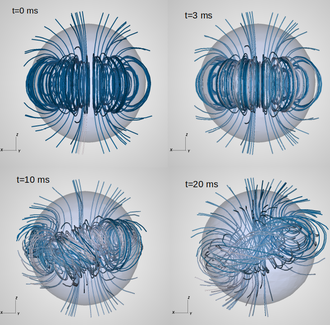
In a recent paper submitted to Monthly Notices of the Royal Astronomical Society, a team lead by Ankan Sur, PhD student at CAMK, has presented dynamical MHD simulations of magnetic field configurations in neutron stars.
Neutron stars are fantastic laboratories in which to study fundamental physics in conditions that cannot be accessed in terrestrial experiments, and the magnetic field plays a key role in determining the nature of both the electromagnetic and gravitational wave emission that we can detect from Earth.
The simulations show that for all initial conditions the magnetic field settles down in a configuration where the poloidal field dominates, but approximately 20% of the magnetic energy is in a toroidal component, creating a ‘twisted-torus’. The field is, however, turbulent and non-stationary, just as the magnetic field of the sun.
These results will be used to aid and interpret astronomical observations of magnetic fields in neutron stars with the NICER X-ray mission, and gravitational wave observations with the LIGO, Virgo and Kagra detectors.
In the picture: Magnetic field lines showing the development of the 'twisted-torus'
configuration in a neutron star. A complex multipolar structure emerges
at the surface while the magnetic field is dipolar outside the star.






